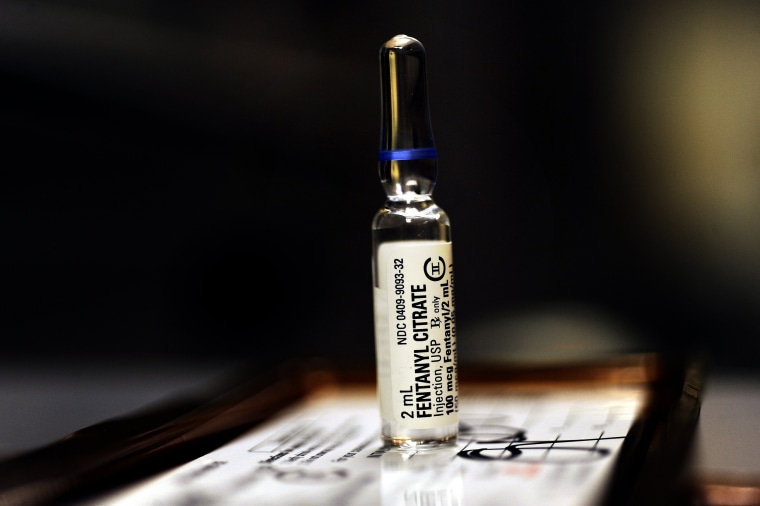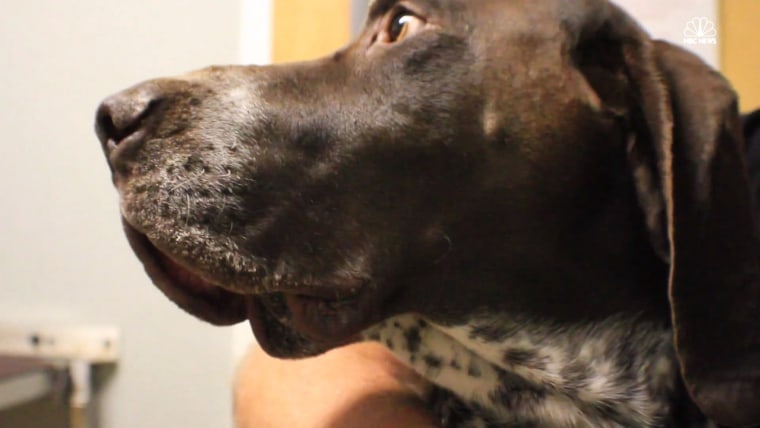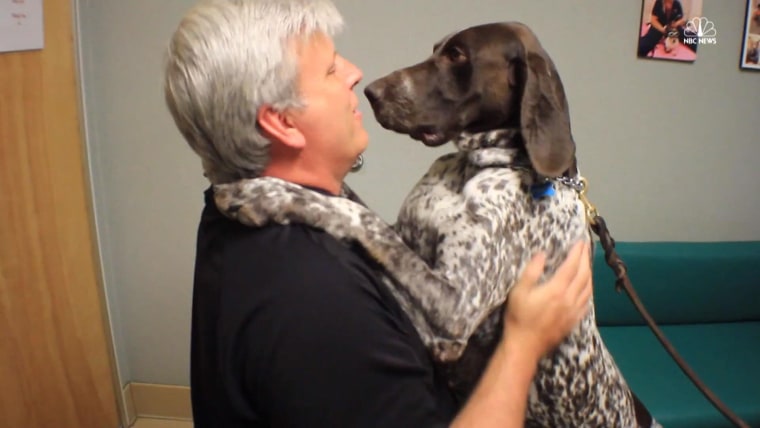Primus, a Florida police dog, is normally a spirited animal. But after assisting in a federal drug raid early one morning last month, he seemed out of sorts.
"He wouldn't drink water. He would release his toy very easily. And he was looking lethargic, almost sedated," said Detective Andy Weiman, the head of dog training for the Broward County Sheriff's Office.
"We knew something was wrong."
Primus was rushed to a local animal hospital. By the time he arrived 10 minutes later, the German short-haired pointer was in serious distress — his tongue was hanging out of his mouth, his breathing had slowed dramatically and he seemed to be staring off into the distance.
"He had to be carried in," Weiman said.
These were classic signs of a drug overdose, and it turned out that while Primus and two other dogs sniffed their way through the suspect's house, they were exposed to unseen fentanyl, a synthetic opioid that is 50 times stronger than heroin sold on the street.
Fentanyl, much of it coming from Mexico and China, has killed hundreds of users, including music legend Prince, since its availability spiked in 2013. But the Drug Enforcement Administration says it also poses a "grave threat" to first responders and law enforcement officers — human and canine.
It's so potent that a few grains can be deadly. It can be ingested, inhaled or absorbed through the skin and mucous membranes. And because dealers cut other drugs with it, fentanyl is often a hidden menace, especially for dogs using their noses to pick up a scent.

In the Broward County raid, investigators believed there was likely no fentanyl at the site because the supplier was arrested weeks before the search warrant was executed. The handlers of Primus and his fellow K-9 unit members Packer and Finn swept the house looking for any dangers before the dogs were sent in.
"If fentanyl is loose in an environment, it can spread out where a dog can absorb it through his pads. He could sniff it up through his jowls," Weiman said.
"And fentanyl is so toxic, so strong that the very smallest amount of it — that you couldn't even see — could affect the dog. You wouldn't know they've even ingested it."
At Coral Springs Animal Hospital, staffers who examined Primus and the other dogs immediately realized they were dealing with classic opioid overdoses and that speed was critical.
"Usually when a person dies of an opioid overdose, they stop breathing. Same with animals," said veterinarian Christopher McLaughlin. "And the treatment for dogs is the same as it is for people."

Narcan, the brand name of the opioid antagonist naloxone, is metabolized as quickly as fentanyl and can reverse an overdose if administered in time. All three dogs got shots of it and perked up within a few minutes.
"By 4 p.m. that afternoon he was fine," Weiman said of Primus, who is a currency detection dog. "And we went back to work the next day."
Even before Primus' brush with death, police officers across the country knew fentanyl in powder or pill form could be hazardous during a raid.
In August, two Atlantic County, New Jersey, detectives were hospitalized after inhaling the pain killer when a puff of it escaped from a plastic bag of heroin and cocaine during a field test.
"I felt like my body was shutting down," Detective Eric Price said of the experience. "I thought I was dying."
A month later, 11 SWAT officers in Hartford, Connecticut, ended up in the emergency room when a stun device they tossed into a house during a raid sent a batch of fentanyl, scraped off prescription patches often used by cancer patients, into the air.
Hartford Deputy Chief Brian Foley said narcotics officers could deal with the threat by wearing gas masks whenever they enter a drug location, but that would impair their vision and communication.
"So they opt not to do that," Foley said.
In Groton, Connecticut, a fentanyl scare prompted the police department to suspend field tests, but that created problems because the courts require the results of those preliminary tests to issue arrest warrants.
Field tests have resumed but now officers wear respirators, dust masks, latex gloves and long-sleeve shirts when testing any powder, said Sgt. Anthony LaFleur. If fentanyl is highly suspected, the sample gets shipped right to the lab.
"It's well worth not risking an exposure to one of our officers," LaFleur said. "Even the most minute disturbance can make this go airborne."
The incident in Broward has also triggered changes. The Coral Springs vets have since trained dozens of officers in the region to recognize and respond to K-9 fentanyl exposure, and dog handlers in the sheriff's office will start carrying Narcan to treat a suffering dog before symptoms get out of control.
The Oct. 27 overdoses marked the first time a Broward K-9 was sickened by ingesting a drug, Weiman said.
"It did open our eyes to how easy it is for it to happen," he said, describing the incident as "very stressful" for Primus, Packer and Finn's handlers.
"They live with our handlers," he said. "So to see their family member, basically, about to die if we don't give the treatment is a very hard thing to watch."

